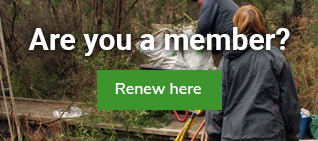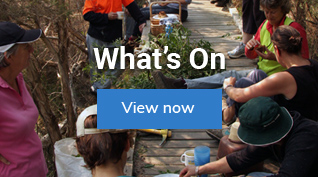Fauna of the creek and wetlands
Several fish species find shelter in Balcombe Creek and its estuary, in underwater logs and branches, among reeds, and in hollows below high water mark. Species include the Short-finned Eel, Common Galaxia, Spotted Galaxia, Broad-finned Galaxia, the nationally threatened Dwarf Galaxia, Southern Pygmy Perch, Small-mouthed Hardyhead, Flat-headed Gudgeon, Blue-spot Goby, Bridled Goby, Yellow-eyed Mullet, Greenback Flounder and Smooth Toadfish.
Wetland birds benefit from the estuary’s varying water levels and rich food supplies, and thick reeds along the banks provide nesting and roosting places. You may see two birds of State significance: the Great Egret and the Royal Spoonbill. There are Cormorants, Pelicans, Ducks, Rails, Crakes, Water Fowl (Swamphens, Moorhens and Coots), Ibis and Herons, including Nankeen Night Herons. Swans, regular visitors a few decades ago, are no longer seen on the estuary, possibly because sediment has smothered the sea grasses.
(see the Balcombe Estuary Bird List)
Frogs include the Common Froglet, Southern Bull Frog, Spotted Marsh Frog, Southern Brown Tree Frog, Verreaux’s Tree Frog and the State-significant Southern Toadlet. Occasionally, a Common Long-necked Tortoise can be seen surfacing for air.
To fish the creek, you need a Recreational Fishing Licence — for details, contact http://agriculture.vic.gov.au/fisheries/recreational-fishing/fishing-licence
Fauna of the woodlands
Reptiles find shelter among fallen logs and plants of the understorey. They include the Common Scaly-foot, Tree Dragon, Southern Water Skink, Delicate Skink, Garden Skink, Weasel Skink, Eastern Three-lined Skink, Blotched Blue-tongue, Lowland Copperhead and the Tiger Snake. The elusive Vulnerable Swamp Skink could also be found here in the near future.
Many small birds live among the scrub, including Robins, Whistlers, Wrens, Flycatchers, Yellow Robins, Pardalotes, Grey Shrike Thrush, Finches, Mistletoebirds, Fantails, three species of Thornbills, a number of different Honeyeaters. Larger birds include Frogmouths, Kookaburras, Goshawks, Rosellas, Lorikeets, Magpies, Ravens and – only recently – large flocks of Yellow-tailed Black Cockatoos.
(see the Balcombe Estuary Bird List)
Mammals to be seen include Short-beaked Echidnas, Common Brushtail and Ringtail Possums, Sugar Gliders, several Micro Bat species, and an occasional Koala. Numerous Swamp Rats dig burrows among the Melaleuca scrub. Once, there were Quolls, Antechinus, Bandicoots, Feathertail Glider, Kangaroos and possibly Water Rats, all now gone from the area. The Black Wallaby, however, has returned after an absence of ten or so years.
Introduced species have a major impact on the native fauna. Birds including the Common Blackbird, Common Myna, Common Starling, Spotted Turtle-Dove and House Sparrow compete aggressively with the locals for hollows and food, and spread environmental weeds. Destructive introduced mammals include the Fox, Feral Cat, Rabbit, Black Rat and House Mouse.
Flora
Before white settlement the lands surrounding Balcombe Creek supported well defined plant communities – Coastal Banksia Woodland, Manna Gum Woodland, Swamp Scrub, Aquatic Herb Fields, and Saltmarsh. A heath under-storey thrived with periodic burning.
Much of Banksia and Manna woodlands are now gone, replaced in part by Coastal Tea-tree. Understorey herbs include Common Lagenifera, Scented Sundew and Sandhill Swordsedge. Dainty native orchids can be seen in light shade. They include Greenhoods, Sun Orchids, Gnat Orchids, and Hyacinth Orchids. Among the native grasses are Common Tussock-grass and Weeping Grass. Middle storey shrubs include Wattles, Correas and Hibbertias.
Near the creek, the dominant vegetation is Swamp Paperbark, with the understorey species depending on the salinity levels and flooding frequency. Aquatic herbfield species, at the saline fringes of the Swamp Paperbark, include Swamp Crassula, Creeping Brookweed, Shiny Swamp-mat and Chaffy Saw-sedge, Knobby Club-sedge, Australian Salt-grass and Beaded Glasswort. There are also reed beds dominated by Phragmites (Common Reeds) and Juncus (Rushes).
The reserve contains a number of regionally significant species considered rare or threatened: Cherry Ballart, Chaffy Saw-sedge, Grassland Cranesbill, Knobby Club-sedge, and Coarse Twine-rush.
Help to protect the Reserve:
- Stay on designated paths.
- Keep your dog on the lead and remove droppings.
- Take your rubbish home with you.
- Remove pest plants and invasive weeds from your garden (to reduce the chances that seeds can be blown or carried into the Reserves eg Forget-Me-Nots, Lilies, Polygala, Pittosporum).
CLICK HERE to read about Berg Mt Martha’s Flora & Fauna Surveys





